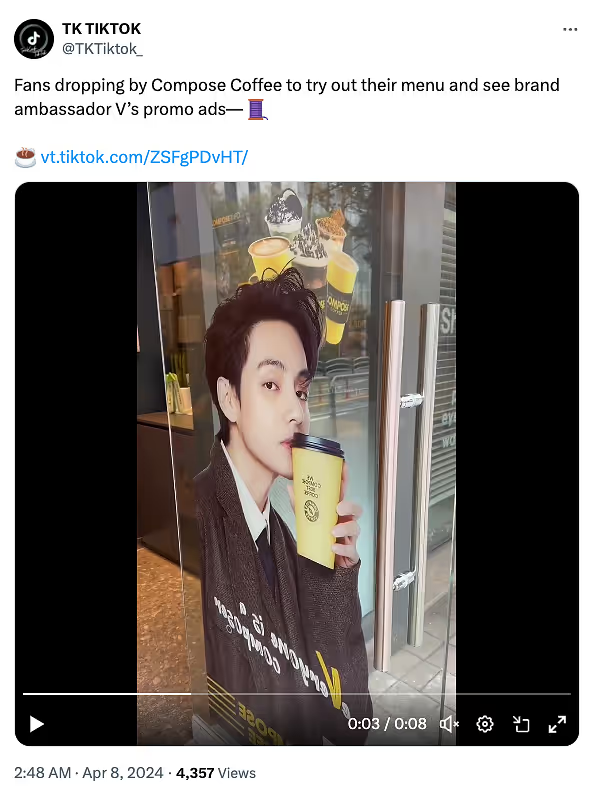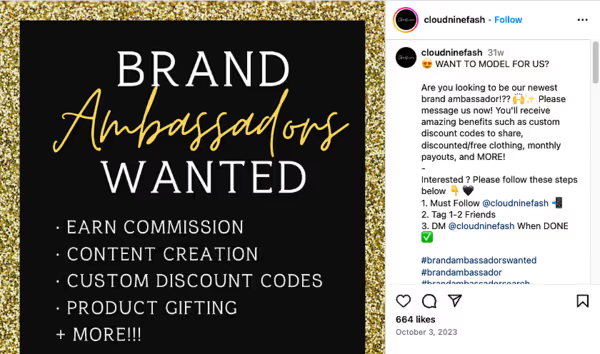Summary
Have you ever heard the phrase, “turn loyal customers into brand ambassadors?”
That should be the goal of every business. Because when someone becomes an ambassador for your brand, they tell everyone they know how great it is.
This opens up the door for more potential customers. And more customers means more sales. With more sales comes a greater opportunity to create loyal customers.
And if they’re happy with the experience, they’ll advocate for your business, too.
See the cycle?
That’s the power of a brand ambassador program.
📈💡 Show your brand ambassadors on your website or shop
Get engagement and drive conversions by displaying content from your best influencers.
🌟 Why Flockler?
- Supports Instagram, TikTok, and 13+ platforms. No tech skills required.
- Super easy. It offers a simple drag-and-drop experience.
- Design to fit your brand: adjust colors and design with no code.
What Is a Brand Ambassador Program?
Let's consider a few stats to understand what it means to have brand ambassadors.
The customers that brands acquire through word-of-mouth marketing spend 200% more than the average customer. 20% of North American customers who discover a product through word-of-mouth make a purchase right then and there.
And it gets better. When people hear about brands from other people, this generates two times as many sales as paid ads.
With that said, a brand ambassador program is a marketing strategy that recruits people to advocate for and promote a brand.
It’s similar to influencer marketing, but it can include customers, employees, or business partners.
So, why is using brand ambassadors so beneficial for businesses looking to promote their products and services?
Brand ambassador programs:
- Build long-term relationships between customers, influencers, or celebrities
- Foster a sense of community, loyalty, and advocacy among customers
- Generate exposure to new audiences and increase brand awareness
- Humanize companies by putting a face to the name
That last bullet point represents the actual value of a brand ambassador program. People may know your company by name. But when you put a face to it, they’re more likely to connect with your business on a deeper, more personal level.
And by getting product recommendations from other people who have positive experiences with your business, there’s a strong chance they’ll make a purchase.
Let’s look at an example of a business that uses advocates to vouch for its products and attract more customers.
Cloudbeds has a great ambassador program that seeks to promote its hotel operations software.

Ambassadors are asked to submit referrals through a dedicated ambassador portal. When a referral makes a first payment, the ambassador gets rewarded with monetary incentives, gift cards, Cloudbeds credit, and more.
This program is a win-win for both parties. Cloudbed sells more software, and ambassadors earn their incentives. Talk about a no-brainer way to boost sales.
5 Steps to Starting an Ambassador Program
So, how do you go about setting up your ambassador program? Follow these five simple steps.
1. Set Measurable Goals
Building brand awareness and driving sales are popular goals for creating a brand ambassador program.
However, many other reasons exist for businesses to work with brand ambassadors. For example, a brand like Adidas has already generated global awareness and gets steady monthly sales.
Why else would it create a brand ambassador program? Maybe to build brand loyalty, engage with its target audience, or create a strong brand community.
One of these reasons is likely why Adidas chose to work with well-known professional football player David Beckham for more than two decades, since 2003, when they signed him to one of the most lucrative deals in sports marketing history – getting lifetime branding and endorsement rights. It’s safe to say that he’s the face of the brand.
But every business is different, from the industry you’re in – to the target audience you want to reach. So, what’s your goal?
Think about what you want to achieve with your brand ambassador program. And make sure you can measure the goal.
For example, if you’re targeting brand awareness, you can measure the success of your campaign with surveys, questionnaires, brand recall tests, or social media listening.
Or, if you want to increase engagement across your social media platforms, you’d monitor likes, shares, or comments on your ambassadors’ posts.
So, whatever goal you choose, identify your metrics and key performance indicators (KPIs) that’ll measure the effectiveness of your program.
2. Choose Your Channels
Social media is one of the most popular channels for brand ambassador programs. Ambassadors use platforms like Instagram, X (formerly Twitter), Facebook, LinkedIn, and TikTok to build a platform and engage with their audience.
However, investing in building a social media presence isn’t the only route businesses take when creating brand ambassador programs.
Some brands launch their programs through:
- Blogs and websites: Bloggers with an established audience base share content related to their interest on their blogs or websites. They often create sponsored blog posts, reviews, or articles that showcase the brand and its products/services to their followers.
- Video platforms: Many brands use YouTube and other video platforms like Vimeo and Twitch for their ambassador programs. Ambassadors can create different types of videos, including product reviews, tutorials, unboxing videos, and other content that highlights the brand.
- TV advertisements: Some companies use TV ads to reach a broad audience. In their commercials, they feature ambassadors to increase brand visibility and credibility.
- Audio platforms like podcasts and radio stations: Podcasts have become popular for brand partnerships and ambassador programs. Ambassadors appear as podcast guests or even host their own podcasts to discuss topics related to the brand’s industry or products.
- Events: Events and workshops give brand ambassadors a chance to engage with audiences in person. These events could include industry conferences, meet-and-greets, or product launch events.
- Email marketing: Companies can send promotional emails that showcase the benefits of their products or services. They can build trust by mentioning their brand ambassadors and featuring the positive things they have to say about the brand and its products.
- Brick-and-mortar locations. Brands with physical locations can host in-store events, pop-up shops, or ambassador meet-ups to create face-to-face interactions with customers and ambassadors.
Korean coffee brand Compose Coffee features its brand ambassador and K-pop superstar, V, at its brick-and-mortar location.

In short, invest in the proper social media channels or other outlets to best serve your customer base.
3. Start Looking for Ambassadors
Once you’ve set your goals and figured out how you want your ambassadors to promote your business, it’s time to find the people who will represent your brand.
Who do you want to be your ambassadors? Do you want your loyal customers to be your advocates?
What about celebrities or influencers?
Make sure you thoroughly vet your potential brand representatives. They should post content relevant to your business, products, and industry.
To find potential ambassadors, look at your current customers, employees, or social media followers.
You can also monitor brand mentions. This will help you discover people who are talking about your business on the internet, whether it’s on websites, videos, or social media.
If they’re saying positive things about your company, then they’d probably love to work with you.
Take a look at the following. How many people are they reaching? What’s the engagement rate? Are the topics they post about relevant to your company and offerings?
Think about these things as you choose the right ambassadors.
The next step is to reach out or set up an application process. You can send emails or direct messages (DMs) on social media to potential brand ambassadors explaining the benefits of joining your program.
Or, you could have ambassadors come to you. Create a social media post encouraging potential advocates to contact you to learn about your brand ambassador program and how to join.

Consider setting criteria for accepting people into your program. For example, you might want content creators to have a certain number of followers.
4. Iron Out the Details of Your Program
Create guidelines for your brand ambassadors. These might include how often they post, the type of content they should create, and any other details.
You’ll also want to determine how to reward and recognize your brand ambassadors. Maybe you want to pay them per post or base your payment on the number of engagements they get per post. You could also offer free products or discounts.
This works well for many brand ambassador partnerships, as 93% of influencers are willing to work with a brand for free products.
Other ways to reward ambassadors include reward points, gift cards, store credit, sales commissions for affiliates, or cash.
After determining your compensation structure, determine how your ambassadors can best represent and position your brand to their audience. Share your vision for the campaign. Share your brand story and offer ideas for creative ways for your ambassadors to communicate it.
Provide them with your brand guidelines to ensure all their content and messaging truly resonates with your brand and ideal customer.
5. Encourage User-Generated Content (UGC)
Get your brand ambassadors to organic content about your brand or product. We call this user-generated content (UGC). This is content that people who use your products or services create online.
Whether a blog post or an engaging social media video, UGC is highly effective for brand ambassador programs.
UGC is authentic and relatable, meaning people are likelier to trust what users say about your product.
79% of consumers say that UGC highly impacts their purchasing decisions.
Takeaway
People trust other people when it comes to product and brand recommendations. This is why brand ambassador programs have become so popular over the years.
Whether it’s a customer, employee, influencer, or celebrity endorsing your brand, potential customers may see it and think, “This company must be awesome.”
Are you ready to build your successful brand ambassador program?
Ryan Robinson
I'm a blogger, podcaster, and (recovering) side project addict who teaches 500,000 monthly readers how to start a blog and grow a profitable side business at ryrob.com.
LinkedIn: https://www.linkedin.com/in/theryanrobinson/
Twitter: https://twitter.com/TheRyanRobinson







